Mosses, Liverworts, and Lichens
Media
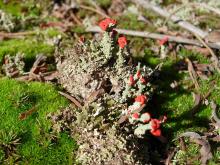
Species Types
Scientific Name
Cladonia cristatella
Description
British soldier lichen is widespread in eastern North America. Branching stalks with bright red knobs at their tips arise from a patch of small, green scalelike structures. The red is similar to the color of British soldiers’ coats during the American Revolution.
Media
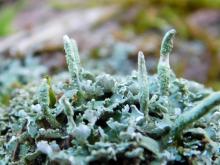
Species Types
Scientific Name
Cladonia coniocraea
Description
Common powderhorn’s slender, gray-green, hornlike fruiting structures emerge from a carpet of gray-green, scalelike squamules. This lichen usually grows on old, damp wood, often on tree bases, in shady areas.
Media
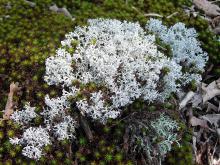
Species Types
Scientific Name
Cladina rangiferina (syn. Cladonia rangiferina)
Description
Gray reindeer lichen, also called reindeer moss, takes the form of bright ashy or silvery-gray, branching cushions that grow on the soil. The branch tips usually bend to point in the same direction, as if combed or blown by a strong wind.
Media
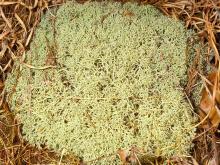
Species Types
Scientific Name
Cladina subtenuis (syn. Cladonia subtenuis)
Description
Dixie reindeer lichen, also called reindeer moss, takes the form of pale yellow-green, finely branched cushions that grow on the soil. This is the most common and widespread of Missouri’s reindeer lichen species.
Media

Species Types
Scientific Name
4 species in Missouri
Description
With their flattened, green forms, hornworts resemble liverworts, but their spore-bearing structures are elongated and horn-shaped. As with liverworts and mosses, hornworts make forest floors, streamsides, and spring openings beautiful.
Media
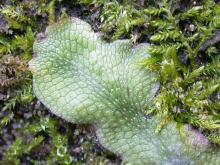
Species Types
Scientific Name
About 112 species in Missouri
Description
Liverworts, along with mosses, make forest floors, streamsides, and spring openings beautiful. They’re fascinating but overlooked.
Media
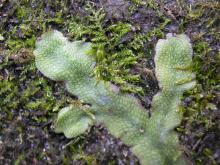
Species Types
Scientific Name
Conocephalum salebrosum (formerly C. conicum)
Description
Snakeskin liverwort looks like large, flattened, irregular, overlapping straps. The surface is covered with polygon-shaped air pores, giving it a bubbly appearance similar to snakeskin. Look for it along streams, springs, and the moist bases of bluffs.
Media
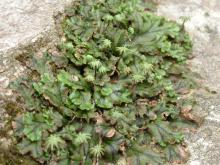
Species Types
Scientific Name
Marchantia polymorpha
Description
Umbrella liverwort is the most famous liverwort in the world. It grows in green ribbons and is very common on the soil of potted plants. It typically forms cuplike gemmae on its upper surface. Its palm-tree-shaped archegona are distinctive, too.
Media
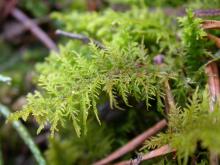
Species Types
Scientific Name
Thuidium spp.
Description
Easy to identify, fern mosses look like tiny ferns. Just like many fern fronds, the branches lie on one plane and become shorter toward the tips. They even lean over like fern fronds.
Media
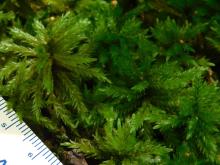
Species Types
Scientific Name
Climacium americanum and Climacium kindbergii
Description
Tree mosses in genus Climacium look like miniature trees, complete with tiny upright trunks and long, slender branches clustered at the top. They form dense, thick mats in moist, shady places.
See Also
About Mosses, Liverworts, and Lichens in Missouri
Mosses, liverworts, hornworts, and lichens seem rather similar, but these organisms are in very different groups. Mosses, liverworts, and hornworts are small, low plants usually found in damp habitats. Unlike more familiar plants, they lack veinlike structures and do not produce flowers or seeds — instead, they produce spores. Meanwhile, lichens are not plants at all: they are a collection of different fungi that have photosynthetic algae living within their tissues.





















